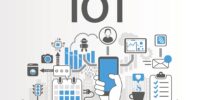Why Data Analytics Is Essential for Making Sense of Iot Data

Are you struggling to make sense of the vast amounts of data generated by the Internet of Things (IoT)? Look no further.
In this article, we’ll explore why data analytics is essential for understanding and extracting valuable insights from IoT data.
Discover how you can leverage data analytics to overcome the complexity and challenges associated with analyzing IoT data.
Get ready to uncover the best practices for implementing data analytics in your IoT projects and learn about the future of this crucial technology in the IoT space.
Key Takeaways
- Data analytics techniques are crucial for extracting valuable insights from the vast amount of IoT data generated by devices.
- Data visualization plays a vital role in understanding the complexity of IoT data and uncovering patterns, trends, and insights.
- Leveraging data analytics allows for informed decision-making, improved operational efficiency, and identification of areas for improvement.
- Overcoming challenges in analyzing IoT data, such as data integration, transformation, aggregation, and security measures, is essential for effective data analysis.
The Role of Data Analytics in IoT Data Analysis
You can’t overlook the importance of data analytics in analyzing IoT data. Data analytics techniques play a crucial role in making sense of the vast amount of data generated by IoT devices.
With the help of data analytics, you can extract valuable insights from this data and use it for data-driven decision making. By using advanced algorithms and statistical models, data analytics techniques can identify patterns, trends, and anomalies in IoT data.
This allows you to understand user behavior, optimize processes, and improve operational efficiency. Data-driven decision making based on these insights enables you to make more informed and strategic choices, leading to better outcomes.
Therefore, embracing data analytics is essential for effectively analyzing and leveraging the wealth of information that IoT devices generate.
Understanding the Complexity of IoT Data
To truly grasp the intricacies of IoT data, it’s important to understand the complexity that it presents. Here are three key points to help you navigate the complexity of IoT data:
- Variety of Data Sources: IoT data comes from a wide range of sources, including sensors, devices, and machines. Managing this complexity requires you to have a clear understanding of the different types of data and how they interact with each other.
- Volume and Velocity: The sheer volume and velocity of IoT data can be overwhelming. With billions of devices generating data in real-time, it’s crucial to have effective data management strategies in place to handle the continuous flow of information.
- Data Visualization: To make sense of the complexity, data visualization plays a vital role. Visualizing IoT data in charts, graphs, and dashboards helps you uncover patterns, trends, and insights that might not be apparent in raw data. It enables you to communicate complex information in a more digestible and actionable way.
Leveraging Data Analytics to Extract Actionable Insights
When it comes to making informed decisions, actionable insights through analytics are crucial.
By leveraging data for insights, you can gain a deeper understanding of your business’s performance and identify areas for improvement.
With the power of data analytics, you can uncover valuable trends and patterns that can drive strategic decision-making and ultimately lead to business growth.
Actionable Insights Through Analytics
By leveraging data analytics, you can gain actionable insights from IoT data. This allows you to make informed decisions and drive meaningful outcomes. Here are three key benefits of using data analytics for extracting actionable insights from IoT data:
- Real-time analytics: With the power of data analytics, you can analyze IoT data in real-time. This means that you can monitor and respond to events as they happen, enabling you to identify and address issues promptly. Real-time analytics provides you with the ability to make immediate decisions based on up-to-date information.
- Predictive modeling: Data analytics allows you to go beyond just understanding what has happened in the past. By leveraging predictive modeling techniques, you can anticipate future trends and outcomes. This empowers you to proactively take actions to prevent problems, optimize processes, and seize opportunities before they arise.
- Actionable insights: Data analytics helps you uncover valuable insights from your IoT data. These insights are actionable, meaning that they provide you with specific recommendations or steps to take. By acting on these insights, you can improve operational efficiency, optimize resource allocation, enhance customer experiences, and drive overall business growth.
Leveraging Data for Insights
Leveraging data allows you to gain valuable insights and drive meaningful outcomes. With the increasing amount of data being generated by IoT devices, it is crucial to make sense of this data through data visualization and predictive analytics.
Data visualization helps you to understand complex data sets by representing them visually, making it easier to identify patterns, trends, and outliers. This visual representation enables you to communicate data-driven insights more effectively, facilitating better decision-making and understanding.
Additionally, predictive analytics uses historical data to make predictions about future outcomes. By analyzing patterns and trends in the data, you can anticipate potential risks, identify opportunities, and optimize your business processes.
Leveraging data through data visualization and predictive analytics empowers you to make informed decisions and gain a competitive edge in today’s data-driven world.
Overcoming Challenges in Analyzing IoT Data
When it comes to analyzing IoT data, you’ll need to consider a few key points: data integration techniques, data privacy, and security.
First, data integration techniques are essential for bringing together data from various sources and making it usable for analysis.
Second, data privacy is a crucial aspect to consider, as you’ll need to ensure that sensitive information is protected and handled in compliance with regulations.
Data Integration Techniques
To better understand the complex web of IoT data, you need to explore various data integration techniques. These techniques help you combine and analyze data from different sources to gain valuable insights.
Here are three important data integration techniques to consider:
- Data transformation techniques: This involves converting data from one format to another, making it easier to analyze and interpret. It may include tasks like data cleaning, standardization, and normalization.
- Data aggregation methods: This technique involves combining multiple data sets into a single, unified view. It helps you gather information from various sources and create a comprehensive picture of your IoT data.
- Data virtualization: This technique enables you to access and use data from different sources without physically moving or duplicating it. It provides a virtual layer that allows you to integrate and analyze data in real-time, reducing complexity and improving efficiency.
Data Privacy and Security
Now that you understand how data integration techniques help in consolidating and connecting IoT data, let’s delve into the importance of data privacy and security.
As an individual or organization, you must prioritize data governance to safeguard sensitive information from potential data breaches. By implementing robust security measures, such as encryption and access controls, you can ensure that your IoT data remains confidential and protected from unauthorized access.
Data breaches can have severe consequences, including financial losses and damage to your reputation. Therefore, it is crucial to establish comprehensive data governance policies and procedures to mitigate these risks.
Best Practices for Implementing Data Analytics in IoT Projects
You should follow best practices for implementing data analytics in your IoT projects. By doing so, you can ensure that your data is analyzed effectively and efficiently, leading to valuable insights and informed decision-making.
Here are three important best practices to consider:
- Define clear objectives: Before implementing data analytics, clearly define the goals and objectives you want to achieve. This will help you focus on the specific insights you need and avoid wasting resources on irrelevant data.
- Choose the right tools and technologies: Selecting the appropriate tools and technologies for data analytics implementation is crucial. Consider factors such as scalability, compatibility, and ease of use to ensure that you have the right capabilities to handle and analyze the data generated by your IoT devices.
- Ensure data quality and integrity: Data integrity is essential for reliable and accurate analysis. Implement data validation processes to ensure the data collected is complete, accurate, and consistent. Regularly monitor and maintain the quality of your data to prevent errors or discrepancies that could impact the accuracy of your analysis.
Following these best practices will help you optimize the implementation of data analytics in your IoT projects, leading to valuable insights and better decision-making.
The Future of Data Analytics in the IoT Space
The future of data analytics in the IoT space is rapidly evolving, with advancements in technology and an increasing amount of connected devices. As AI continues to make strides, its impact on data analytics in IoT is becoming more significant. Machine learning plays a crucial role in analyzing the vast amounts of data generated by IoT devices. Through its ability to identify patterns and make predictions, machine learning enables businesses to derive valuable insights from IoT data.
| Impact of AI on Data Analytics in IoT | Role of Machine Learning in Analyzing IoT Data |
|---|---|
| AI enhances data analytics by | Machine learning algorithms play a vital |
| automating the process and | role in analyzing IoT data. They can |
| improving accuracy in deriving | identify trends, detect anomalies, |
| insights from IoT data. | and make predictions, enabling businesses |
| to make informed decisions and optimize | |
| their operations. |
With the exponential growth of IoT devices and the increasing complexity of the data they generate, the future of data analytics in the IoT space is exciting. AI and machine learning will continue to play a pivotal role in unlocking the full potential of IoT data and empowering businesses to make data-driven decisions.
Frequently Asked Questions
What Are the Potential Security Risks Associated With Data Analytics in Iot Projects?
Potential privacy risks associated with data analytics in IoT projects include unauthorized access, data breaches, and data misuse. To secure IoT data, implement encryption, access controls, and regular security audits to protect against these risks.
How Can Data Analytics Help in Predicting and Preventing Iot Device Failures?
Data analytics can help you predict and prevent IoT device failures through techniques like predictive maintenance and anomaly detection. This allows you to identify and address potential issues before they cause major problems.
What Are Some Common Challenges Faced When Integrating Data Analytics Into Existing Iot Systems?
When integrating data analytics into existing IoT systems, you may face challenges such as data compatibility issues and the need for skilled personnel. These integration issues can impact the effectiveness of data analytics in making sense of IoT data.
How Does Data Analytics Play a Role in Ensuring Data Privacy and Compliance in Iot Projects?
Data analytics plays a crucial role in ensuring data privacy assurance and compliance monitoring in IoT projects. By analyzing data, you can identify potential privacy breaches and monitor compliance with regulations to protect sensitive information.
Are There Any Specific Industries or Sectors That Have Seen Significant Benefits From Implementing Data Analytics in Iot?
In healthcare, IoT data analytics applications have provided significant benefits, improving patient care and operational efficiency. Similarly, data analytics has had a profound impact on smart cities by optimizing resource allocation and enhancing sustainability.








